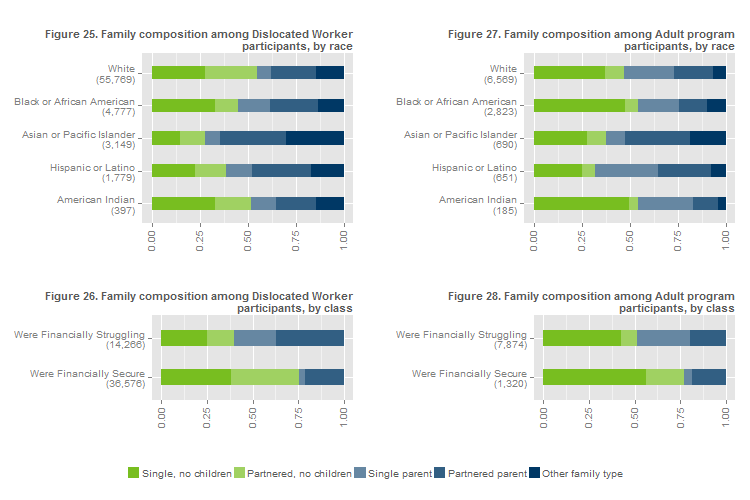Figures 25 through 28 show the family composition of participants, imputed from the participants' total family size and number of dependents under the age of 18.

We know from conversations with people experienced in the job counseling field that the participant's support network is extremely important, not only because of the hidden job market that relies on these informal networks but because they provide mental health, social, and sometimes even financial support. Fourteen percent of counselor respondents reported that having a strong support network is necessary for someone to be a good candidate for long-term training, a resource-intensive endeavor. We do not have information on participants' full support network; however, this information on their immediate family structure provides an indication of at least part of the support network.
In both the Dislocated Worker and Adult programs, Asian or Pacific Islander participants are the least likely to be single parents and have the highest rates of 'Other family type', which means the family has three or more adults living together, with or without children (Figures 25 and 27). This potentially points to cultural difference in support networks across racial groups; namely, the importance of the extended family (See Note 1).
Note that "Other family type" is excluded from the figures showing family type by class. This is because we do not have cost of living estimates for families of three or more adults.
Half of participants who were financially struggling prior to participation were parents, compared to just a quarter of those who were financially secure. Although we do not know the number of dual-income families among the partnered families shown in these charts, logic would suggest that having a partner does increase the chance of weathering an income loss simply because that partner is likely to have an income of their own (See Note 2).
Of course, a support network is often a give and take. Lack of personal support, lack of child care, and overwhelming family obligations were all mentioned by counselors when asked what are the most common barriers to high-quality, living-wage employment. As Shereese Turner, Senior Program Manager at Twin Cities RISE!, said:
"I always use this: more money, more problems, right? That's real. Because now that you're starting to make money, keep in mind that you may still have that same unit that was with you when you were not making any money, and things start to change. The dynamic, the family dynamic changes now. Because they feel like 'OK, you're making money, now I need some support.'"